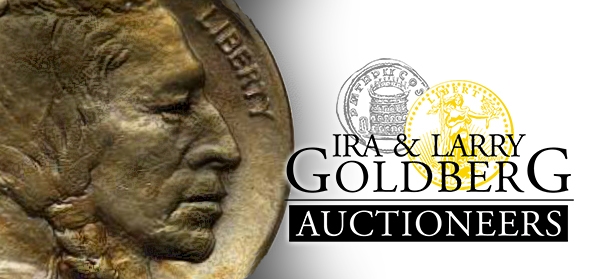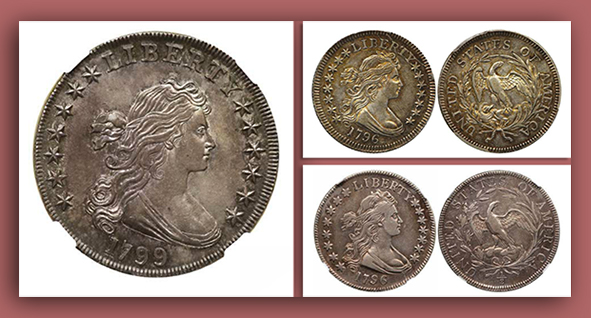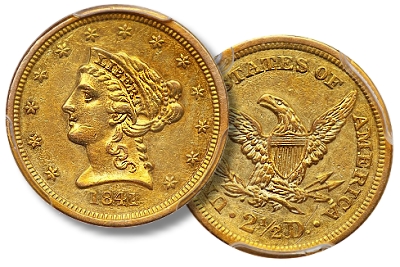
CoinWeek’s coverage of the Pre-Long Beach Auction Continues. Click here to read part one…
Rare 1916 Buffalo Nickel DDO nets top price for Pre-Long Beach U.S. offerings…
Day two of Goldberg’s Pre-Long Beach auction saw the California-based firm offering several great U.S. rarities and high-end type material over the course of two sessions.
Leading the way was an elusive Mint State 1916 Buffalo nickel with a Doubled Die Obverse (FS-101, formerly FS-016).
When Pomona, California coin dealer Herbert S. Perlin discovered a 1916 Buffalo nickel with naked eye visible doubling, he had little idea that the coin would become one of the 20th century’s great rarities. Yet here we are, more than 60 years removed from that discovery, and there have been fewer than 20 grading events of Mint State coins reported by PCGS and NGC.
Of that total, only four examples have CAC’ed: the present coin just sold by Goldberg’s, another one in MS-63, and two other examples graded MS-64 by PCGS.
There’s no doubt that prices for this issue have softened in recent years. A PCGS-graded example in MS-64 brought over $316,000 at the 2007 Stack’s Baltimore auction, only to shed a third of its value when collector Scott Rudolph sold his impressive collection through Heritage in 2009.
Price performance of the specimen offered yesterday by Goldberg’s, shows improvement for the well-known variety.
This exact specimen last appeared at auction in 2012, where it brought $103,627.65 at Heritage Auction’s March 8-11 U.S. Coin signature auction in New York. At the time, the coin resided in an older style NGC holder, wherein it earned the present grade of MS-63. The coin has since been resubmitted and CAC’ed, the coin’s prior cert number having been deleted from the NGC database.
Its new owner paid $126,500.
High Grade 18th century Type

A trio of 18th century Draped Bust coins brought more than $90,000 each. For these coins, it was a mixed bag.
Finishing below expectations was a 1799 Draped Bust dollar (B-9, BB-166, Rarity 1) graded MS-65 by NGC. One of only a handful of gems for the issue (though from a common die pairing), it brought $109,250–considerably less than the pre-sale estimate of $160,000 – $170,000.
Ira and Larry Goldberg describe the coin as having “lilac-gray surfaces with rich, satiny underlying luster that exhibits accents of deep blue and green [when] the coin is rotated under a light source.”
NGC currently reports seven 1799 dollars in MS-65, with two higher (1 MS-66, 1 MS-67).
More elusive was the 1796 quarter on offer.
The quarter denomination debuted as a regular federal issue in 1796, but did not see continued striking until 1804. It was perhaps because of this that a fair number of coins survive in Mint State–though not nearly enough to satisfy collectors–as this is a one-year type coin, and the only quarter dollar struck in the 18th century.
The Goldberg piece is described as having been discovered recently in Europe. It boasts strong details and is partially lustrous with a pleasing goldenrod coloration. The coin realized $94,875, which is considerably more than the $50,000 to $60,000 pre-sale estimate. That figure likely took into account the $64,625 hammer price brought by a non-CAC’ed PCGS AU-55 example that Stack’s Bowers sold at the August 2014 sale of the ANA World’s Fair of Money.
Another 1796 Draped Bust coin brought strong money, this one a 1796 half dollar (15 Stars, O-101) graded EF-45 by NGC.
The 1796 half dollar with 15 stars was rare when struck. Contemporary mintage reports show 3,918 coins, but it’s believed that the majority were dated “1797”. Of those dated “1796” and having 15 stars, PCGS President Don Willis estimates a total mintage of 569 pieces.
To date, NGC has graded eight finer, six of which are in Mint State. For their part, PCGS has graded five finer, with three in Mint State.
The last one in this grade to sell at auction was offered as part of the William Jacob Collection, Part II, at the 2013 Heritage Auction sale at Central States. That specimen, also graded by NGC, brought $91,062.50. The coin offered at Goldberg’s eked by the Heritage specimen, bringing $92,000.
The Little Princess
The 1841 quarter eagle is one of the rarest American issues and has of late become one of the most controversial as well. Long considered one of the most desirable American coins, questions regarding its origin have always beguiled numismatists.
 To paraphrase Winston Churchill, the origin story of the 1841 quarter eagle “is a riddle, wrapped in a mystery, inside an enigma”.
To paraphrase Winston Churchill, the origin story of the 1841 quarter eagle “is a riddle, wrapped in a mystery, inside an enigma”.
Many who have studied the coin consider it a “Proof Only” Issue. But this opinion isn’t universal. When David Akers wrote his landmark volume on quarter eagles in 1975, he wrote “I am not convinced that the 1841 is a proof-only date”. He questioned the number of existent proofs, feeling that that number was too high. He also felt that a number of the coins just didn’t look like proofs.
In February 2012, PCGS changed course and began to attribute most known specimens as business strikes. What effect that shift in policy will ultimately have on the market remains to be seen and one auction alone does not tell the story. [ Editors Note: Read more on the MS vs PR issue in Greg Reynold’s Three Part Series on the topic ]
But the present specimen, graded AU-53 by PCGS, brought $89,125–25% less than the Goldberg’s most conservative pre-sale estimate and nearly half as much as a PCGS-graded PR-53 specimen brought at Heritage’s March 20, 2014 sale of the Donald E. Bently collection. The Heritage coin is presently counted in PCGS’ population report as an AU-53, despite the “PR” designation that remains on its label.
Rounding out the Top 10:
- 1837 Seated Dime (NGC PF67, Finest Graded) $83,375.
- 1916-D Mercury Dime (PCGS MS-66 FB) $63,250.
- 1804 Turban Head Eagle (Crosslet 4) (PCGS MS-61) $57,500.
- 1805 Draped Bust Dime (JR-2, Rarity 2, 4 Berries; PCGS MS-66) $57,500.
- 1904 Liberty Half Eagle (PCGS PR67CAM; top pop) $57.500.
Sessions two and three at the Pre-Long Beach auction brought $4.37 million, bringing the total for U.S. and related coinage to $5.52 million.
The Goldberg’s sale continues today with two sessions covering Ancient and World Gold Coins and wraps up on Wednesday with a session devoted to World Crowns and Minor Coinage. CoinWeek will return with a report on those results on Thursday.




